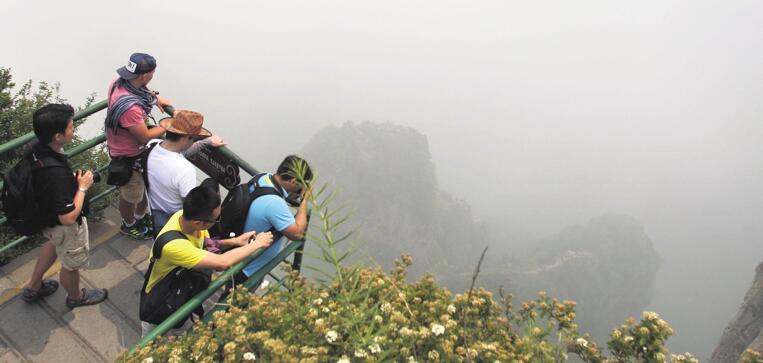
The steep cliffs rising perpendicularly from the valleys are called“iron walls of Taihang”. The term is also a tribute to the heroes who protected the nation by fighting the Japanese invaders seven decades ago. QIN HONGYU / FOR CHINA DAILY

Tourists take a view of the Taihang Mountains on top of the main peak of Wangmangling. WANG ZHUANGFEI / CHINA DAILY
Extending more than 400 kilometers from north to south, the Taihang Mountains are one of the largest mountain ranges in North China and is where the name of Shanxi province comes from.
Shanxi-which means "to the west of the mountains"-is so called because it located to the west of Taihang.
The mountains constitute the border among Shanxi, Hebei and Henan provinces.
Because of its precipitous peaks, steep cliffs, strange rocks, lush forests and clean waters, Taihang is seen by many sightseers as a destination that can be visited many times.
Serving as the natural border of the Loess Plateau in the west and the North China Plain in the east, Taihang also held a strategic position in ancient China in times of conflicts. The relics and legends left by past-day battles make it a favorite for tourists with special interest in China's history and culture.
Zuoquan county in the east of Shanxi is known for its Taihong valleys which are called the"50-km gallery of picturesque landscape" by tourism industry insiders.
One of the most imposing sights in the area are the cliffs rising perpendicularly from the valleys.
The cliffs are often called the "iron walls of Taihang".
In the eyes of the locals, the term "iron walls of Taihang" is not only a description of the landscape, but also a tribute to the heroes who protected the nation by fighting the Japanese invaders seven decades ago.
During the War of Resistance Against Japanese Agression, the Taihang Mountains were an important base for the Eighth Route Army led by the Communist Party of China.
When the nation and the people were at their most critical moment, the warriors of the army pledged to "build a new Great Wall with their very flesh and blood".
General Zuo Quan (1905-42), deputy chief of staff of the army, honored the promise by sacrificing his life during a battle in the county in 1942.
To pay homage to this great hero, the local people changed the name of the county to Zuoquan from its original name of Liaoxian in the same year of his death.
"You can understand the true meaning of 'iron walls of Taihang' only after you have toured Zuoquan and learned about the stories of the heroes who contributed their lives to protecting the nation," said Chang Jinmin, a local tourism official.
Another site that perfectly combines natural wonders and human efforts is the Wangmangling Scenic Area.
The core of the scenic area is the Wangmangling main peak. Standing 1,665 meters above sea level, it is the highest peak in the southern part of the Taihang Mountains.
The peak's top is flat, with four watchtowers on it, showing it had been a strategic place in ancient times.
However, the most impressive part of the scenic area is a road in the middle of the cliffs.
The road was built by local construction workers two decades ago by cutting into the cliffs inch by inch, aiming to offer a passage for the residents at the heart of Taihang to reach the outside and for tourists to get in.
After a riding tour of the road, Stefano Cappello, an Italian tourist, said: "The road is definitely one of the miracles in modern civil engineering, considering it was built mostly by manpower. Now I understand how the Great Wall was built in ancient times."
The hanging road is a favorite of many self-driving tourists.
"I was told the cliff-hanging road in Wangmangling is among the most attractive roads in the world, so I planned a tour of the road during Dragon Boat Festival at the end of June," said Gao Yuan, a resident in Taiyuan, capital city of Shanxi province.
There are six other similar cliffhanging roads in the Taihang Mountains region.
Seeing the Taihang Mountains' great potential on the tourist market, the authorities of Shanxi have rolled out a plan to develop Taihang into one of China's top three touring routes along with the Great Wall and the Yellow River.
In the plan, Taihang is positioned as an international destination for mountain sightseeing and recreation, as well as a destination for historical and cultural tours.
A new sightseeing highway extending from north to south is now under construction, which is expected to link hundreds of scenic spots in and around the mountains.
Li Yali contributed to this story.
By YUAN SHENGGAO
 山西路桥:党建引领 建好“四好农村路”山西路桥建设集团党委扎实开展“党建质量提升年”,实施“六大工程”,立足“十四五”高质量、高速度、高效益发展的战略基点,全面提高党建质量和党建引领发展水平,为打造“国内一流的交通基础设施投资、建设、施工现代化企业集团”提供坚强政治保障。
山西路桥:党建引领 建好“四好农村路”山西路桥建设集团党委扎实开展“党建质量提升年”,实施“六大工程”,立足“十四五”高质量、高速度、高效益发展的战略基点,全面提高党建质量和党建引领发展水平,为打造“国内一流的交通基础设施投资、建设、施工现代化企业集团”提供坚强政治保障。
 常住人口3491万 山西人口普查数据"出炉"山西省统计局向社会通报山西省第七次全国人口普查主要数据。数据显示,山西省常住人口为34915616人,比2010年(第六次全国人口普查数据,下同)减少2.23%,年平均减少0.23%。山西省常住人口总量减少,主要受人口流动变化等因素影响。
常住人口3491万 山西人口普查数据"出炉"山西省统计局向社会通报山西省第七次全国人口普查主要数据。数据显示,山西省常住人口为34915616人,比2010年(第六次全国人口普查数据,下同)减少2.23%,年平均减少0.23%。山西省常住人口总量减少,主要受人口流动变化等因素影响。